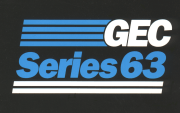GEC Series 63 facts for kids
The GEC Series 63 was a powerful computer built in the 1980s. It was a type of computer called a minicomputer. This machine was created by a British company, GEC Computers, working with an American company, A. B. Dick. While it was being made, people called it the 'R Project'. The parts of the computer were designed in the USA. The programs and software were made in the UK. This computer used a clever trick to work faster. It would start the next task before finishing the one it was on.
What it Did
The GEC Series 63 was announced in 1983. It was designed to run two main operating systems. One was called UX63, which was a version of UNIX System III. The other was OS6000, which came from an older GEC computer system. Later, another version of Unix, called UNIX System V, was added. This was done so the computer could compete with other popular machines. Many universities wanted to use these computers.
Different Models
There were plans to make six different models of the GEC Series 63. However, only two models were actually produced. These were known as the 63/30 and the 63/40. The 63/40 model was special. It had another small computer inside it. This extra computer helped with communication features.
Where it Was Used
The GEC Series 63 computers were used by several universities in the UK. They were also part of a big research project called Alvey. This project aimed to support British-made technology. The GEC Series 63 was chosen as a British option.
One of the first student-run computer centers in the UK used a Series 63. This was at the University of Edinburgh in 1988. The project was famously called The Tardis Project. This name came from the computer's large blue cabinet. It looked a lot like Doctor Who's time machine!
End of the Line
Sadly, the GEC Series 63 was stopped in August 1987. This was because not many were sold. Only about 22 of these computer systems were ever sold.
See also


